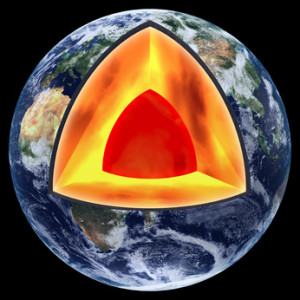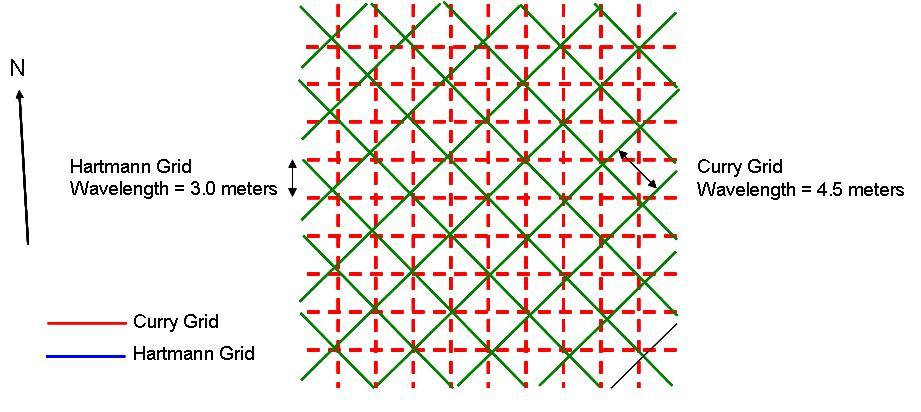Curry Grid
This grid is named after Manfred Curry, an American doctor born in Munich in 1899. Curry spent most of his life in Germany and was an enthusiastic sailor, author and inventor. He invented, among other things, the cam cleat and one of the first velomobiles. Although the grid is named after Curry, who published it in 1952, it was actually discovered by Siegfried Wittmann in 1950.
The Curry grid runs diagonally to the Hartmann global grid. Its lines measure between 12 and 16 inches in width and are spaced between 8 and 11.5 feet apart. Like the Hartmann grid, the Curry grid also encompasses the entire Earth. Moon cycles influence the intensity of the Curry grid. At full moon, energy levels are particularly strong where it intersects with the Hartmann Grid. Some maintain that if it also crosses an underground waterway at that point, it becomes especially dangerous for people. During the day, its intensity wanes, but at night it can lead to insomnia (Bachler and Living, 2007, 217-218; Dale, 2009, 108-109; Schumacher, 2005, 93-97). Experts believe that the Curry grid originates from cosmic radiation rather than radiation from Earth (Leviton, 2001).
Hartmann Grid
Discovered by the physician Ernst Hartmann in 1954 and described in detail in his book Krankheit als Standortproblem (Illness as a Location Problem), the Hartmann grid is associated with the Earth’s magnetic field. Its lines measure between 8 and 12 inches in width approximately. These lines are spaced about 6 feet apart in the north-south direction and about 10 feet apart in the east-west direction. However, these values can vary immensely depending on geographical location The Hartmann grid is often referred to as a global grid. In his book, Hartmann provides clear evidence for the pathogenic character of the grid. See also: Schumacher, 2005, 93-97; Dale, 2009, 108-109.
Benker Grid

This picture is a simplified representation of the Benker grid. The cubes are about 10 meters high and wide and are spaced about 1 meter apart.
Named after the master carpenter and avid dowser Anton Benker, the Benker grid is a spatial system comprised of rows and columns of cubes with a length and breadth measurement of 10 meters (32’9.7”) (Dale, 2009, 108). It is also referred to as the 10 Meter System and the Benker Cubical System. Each cube is electrically charged and the polarity changes from one cube to the next. A positively charged cube should support and encourage life processes, but it can have the opposite effect if exposure is excessive. Similarly, negatively charged cubes usually have a calming effect but can also extract energy from the body if exposure becomes excessive. Electromagnetic influences (electrosmog) distort and amplify the intensity and spread of the Benker grid. This can, in turn, create areas of irritation that are extremely threatening to our health.
Anton Benker conducted experiments on multiple sclerosis and cancer patients, which confirmed their connection with the Benker Cubical System. Researchers have also proposed that, like the Curry grid, the Benker grid results from cosmic influences and not from radiation from the Earth’s interior.
Water veins & faults: the “Real” earth radiation
We believe cosmic influences or the Earth’s magnetic field cause the lattice networks described above. There may be quite a few types of radiation from the Earth’s interior in addition to terrestrial radiation generated by underground running water (aquifers/water veins), rock fractures or faults within the Earth (geologic factors).
Watercourses/Aquifers/Water Veins
Please see the detailed information page about water veins.
Geological influences
Rock fractures
Cracks and crevices in the rock of our inner Earth are called rock fractures. They are like openings and passages that allow natural terrestrial radiation to reach the surface easily. Different rock layers have different fields of electrical voltages. When a rock breaks, it causes these layers to move, which results in higher concentrations of electromagnetic radiation on the Earth’s surface.
Rock faults

Gigantic volcanoes and tectonic movements of glacial rock may be responsible for faults that emit earth radiation, which, under certain circumstances, can cause disease.
Faults are interconnected layers of earth that extend over several hundred meters. Caused by volcanoes or by glaciers during the Ice Age, faults usually occur in or adjacent to medium to high mountains. When different layers of rock merge and react to one another, the interaction of varying electrical conditions and terrestrial radiation creates intense energetic influences.
Based on what individuals have reported experiencing, we believe that these influences manifest themselves primarily as psychological traits or tendencies. For example, someone who lives on a fault may have been inclined toward depression or aggressive behaviour.
Terrestrial radiation
Terrestrial radiation exists everywhere on Earth. Scientists maintain that this radiation is a consequence of radioactive elements left over from the Earth’s formation. The decay of these elements produces gases. Radon, for example, leaks continuously from the ground and can be inhaled easily.

Even after billions of years, radioactive elements formed in the Earth’s interior as our planet was born still emit radiation because of their extremely long half-lives.
In addition to these gases, the Earth also emits alpha and beta radiation. Alpha radiation is considered to be quite “safe” because its particles don’t usually penetrate deeper than the topmost layers of the skin. Beta radiation behaves similarly, although it can cause serious skin irradiations, burns, and cancer with longer exposure. Various types of cancer have been observed in cases where beta radiation had penetrated the body.
The radiation intensity is measured in millisievert per year. In Germany, the average terrestrial radiation exposure is about 0.4 millisievert per year (mSv/a). According to a World Health Organization (WHO) study, a radiation dose of 50 mSv/a is the highest permissible limit for people who work with radiation professionally. An average annual radiation exposure not exceeding 20 mSv is considered to be harmless to health.
earth radiation impact
The consensus about earth rays and their impact remains fraught. Sceptics deny their existence and believe they have no effect. Others have dedicated themselves to researching them and believe the contrary.

Children and infants still have an “antenna” for earth radiation. If they roll around in bed frequently, they are looking for a stress-free spot.
The pathological effects of geopathic stresses are not always immediately obvious. They are gradual and more insidious. Initial symptoms may arise in the form of disorders of the immune system or in an inconspicuous illness that recurs after a short time despite successful therapy and with no apparent explanation. If medication and complementary therapies follow a pattern of temporary improvement followed by subsequent deterioration in spite of further medical or therapeutic care, then you should consider the subtle effect of earth radiation as a possible cause. Often, however, at this point damage is extensive and path to recovery may prove long and tedious.
We assume that geopathic stress symptoms only have a effect when we expose ourselves to them for prolonged periods on a daily basis. This applies primarily and especially to exposure in the bedroom. When we sleep we usually relax completely, reducing our body functions to a minimum. This gives the negative effects of earth rays a better chance to influence us. In most cases, these influences manifest as sleep disorders (e.g. restless sleep, insomnia, and frequent waking). Children are particularly susceptible: when they toss and turn in bed, it may be an unconscious effort to find a stress-free place to sleep.
If you sleep over a source of geopathic stress, more often than not, you will feel exhausted in the morning and may experience back or neck pain. The effects, of phenomena such as geopathic stresses, are subtle and not everyone notices them readily. Even if we cannot observe them, however, they can still affect our health negatively. Long exposures can lead to serious symptoms and diseases.
Scientists have observed that it can take up to five years for diseases, such as cancer, to become symptomatic. In this context, we can also assume that symptom-free people who have slept in the same place for seven years or more without having moved their bed, can be assured that they have no unhealthy earth radiation or water veins in their bedroom.
Anyone who has a desk job and sits in the same place for eight or more hours a day should explore the possibility of harmful earth radiation. This is especially true if he or she feels tired, drained, or exhausted after work, or frequently suffers from headaches or back pain at the end of the day.


No comments:
Post a Comment